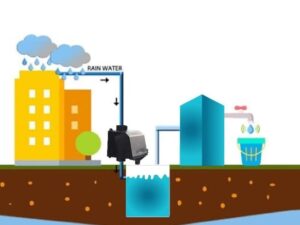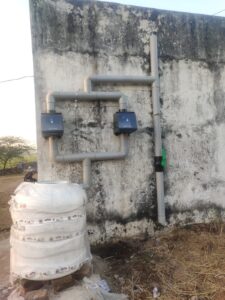An easy step-by-step guide to install rooftop rainwater harvesting (RRWH) at your location.
- Solution for government buildings, commercial buildings, factories, housing societies, educational institutions, individual houses, etc.
Water scarcity, pollution in water bodies, access to clean drinking water, threat to water-dependent ecology, erratic rainfall and climate change are pressing issues around water management. Several government schemes and policies, non-governmental organisations, and private companies work to address these water issues.
Rainwater harvesting is the technique of collection, filtration and storage of rainwater at surface or in subsurface aquifers, before it is lost as surface run-off, such that the collected water can be harvested in the time of need.
You as individual citizens, colony members, school representatives can harvest rainwater falling in your premises.
will bring the major benefits of:
(i) Maintain level of groundwater in borewell, and prevent the threat of borewell drying up which otherwise leads to drilling another borewell
(ii) Maintain or reduce TDS level of water and reduce your water purification needs, especially RO treatment which is installed in most urban households. RO creates a lot of reject water in its process, RWH will reduce dependency on RO treatment.
You also contribute to water conservation.
In this article you can find useful resources to install a roof rainwater harvesting system at your place.
Where to install rooftop rainwater harvesting system?
RRWHS can be installed in any building having a roof area, and space to store rainwater in a tank or recharge your own borewell as groundwater. Government offices, institutions, industries, apartments buildings, bungalows, etc., can install rainwater harvesting systems. Schools can also be a great setting for installing rainwater harvesting systems, as it will meet water needs for students’ and staff, and also inculcate practical learning about water conservation and environment among students.
Types of rainwater harvesting:
Storage:
One way of harvesting rainwater is to store it in a tank on the ground, after filtering it. Depending on water usage and rainfall availability, a large portion of a year’s water needs can be met by this stored rainwater.
 Recharge:
Recharge:
Often, space to make storage tanks for rainwater, is inadequate, and in such cases it can be used to recharge the groundwater.In most cases, a functioning borewell itself can be recharged with rainwater after filtering. In some other cases, a defunct borewell (functioning earlier but now not functional), can be used for recharge. If there is no current borewell, a recharge borewell can be made, after studying the aquifer/groundwater characteristics of the location.
 Combination:
Combination:
RRWHS is often implemented as a combination of storage and recharge. The rainwater, after filtering, is led to an existing storage tank on surface. Overflow from the tank, not uncommon in monsoon, is led to recharge the borewell.
Each Components of a rooftop rainwater harvesting system is explained below:
- Roof: The roof of any building is an important catchment area, which is a surface on which rainwater falls and it can be directed to storage or for shallow aquifer recharge. The roof can be sloping or flat, and it is important to check that the finishing materials or paint used on the roof is non-toxic and does not contain mercury. Before the first rains, it is important to clean the roof thoroughly to avoid dirt and other impurities from mixing with rainwater.
- Pipes: Rainwater can be brought down from the roof through pipes. The size of pipes can be decided as per rainfall intensity and roof area. For aesthetic purposes, sometimes people use rain chains instead of pipes. These chains direct the water flow from roof to floor, reduce splashing and create a good visual as water flowers down.
- First flash valve: The first rain of the monsoon season is not stored because the dirt and organic matter mixes with water and such water can create contamination in storage tank. So the first flash valve removes this water, and subsequent rainwater can be collected.
- Filter system: A filter is needed to prevent stones, leaves, dust and other particles from entering storage tanks or recharge pits. It can be done using NeeRain rooftop rainwater filters to be mounted a few feet above ground on the pipeline bringing water from the roof.
- Storage: The capacity of a storage tank can be designed based on space availability, needs and usage. If the water is to be used for drinking purposes, the tank can be smaller than if the intended use is for non-drinking purposes.
- Recharge and excess outlet: Once the storage tank is filled, the overflow can be directed to recharge groundwater.

- Maintenance
- Check the terrace areas for any major spillage of oil, chemicals or garbage and clean it particularly at the beginning of the monsoon season and then every few months.
- Water from initial two rain should be drained off. Then close the flash valve for subsequent rains, so the water flows from roof through the filter to the tank or recharge as per design.
- If rainwater is being stored and used, then regular water quality tests will have to be done to ensure drinking water standards, and perform treatment if necessary.
- Storage tank should be cleaned once a year especially before the monsoon season.
- Stored rainwater can be disinfected by UV or boiling water before use.
Neerain is proud to republish this article for spreading awareness about situation of water, for our stakeholders. Credit whatsoever goes to the Author.
This article is published by: –
We would like to spread this for the benefit of fellow Indians.
Author: TEAM WIN FOUNDATION
Publish On: Jun 26 , 2021.
